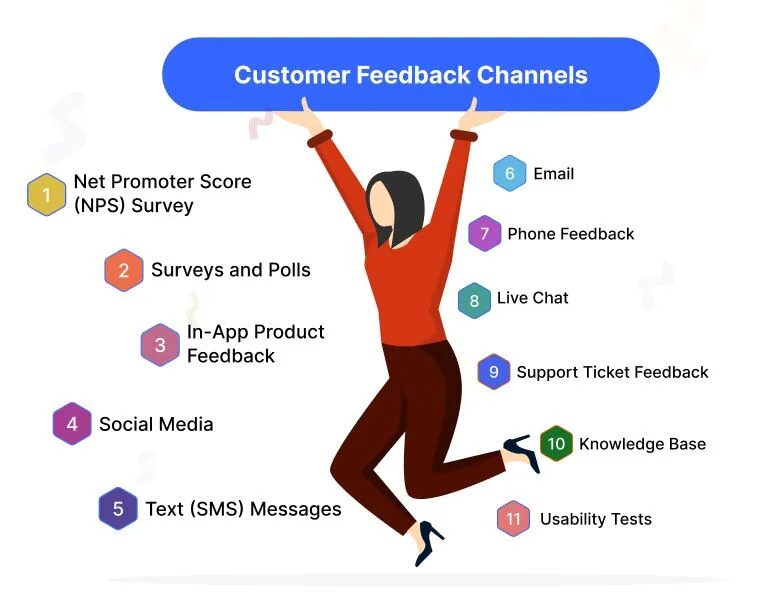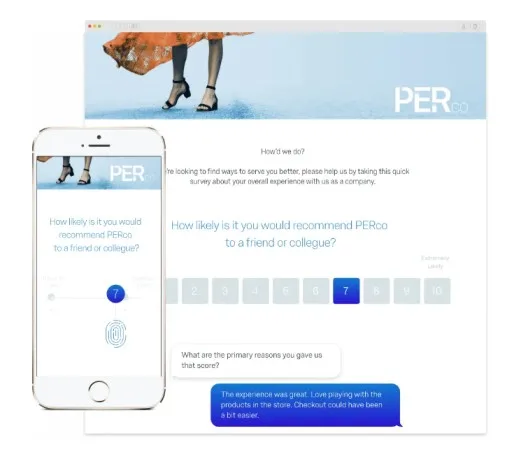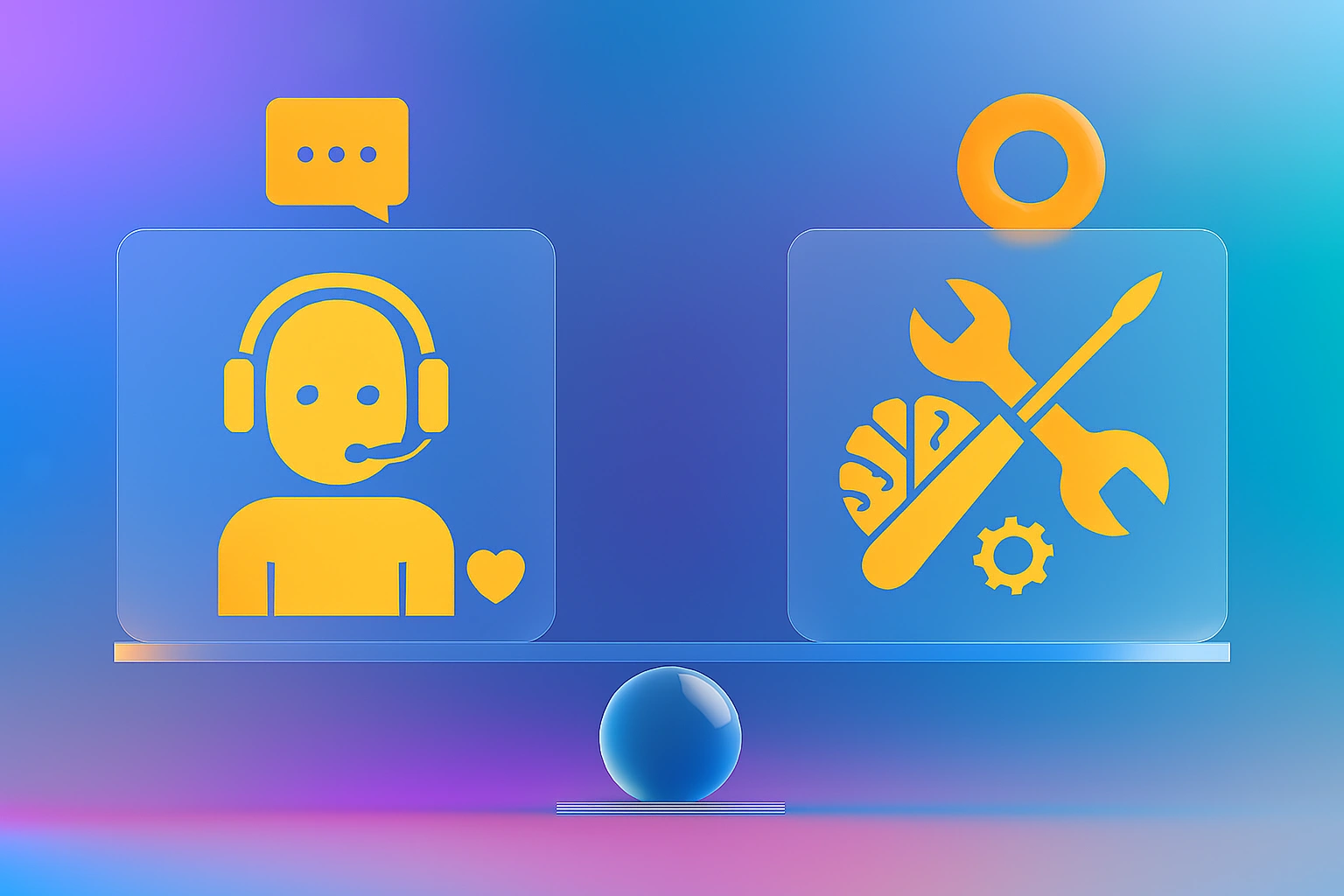What is Customer Feedback Management? Tips, Tools, and Process
- April 10, 2024
- 15 mins read
- Listen

Managing feedback is the key to understanding customer needs better and improving online experiences for them. Brands with a proper feedback mechanism have more happy customers than the rest. However, feedback management is more complex than it looks on the surface, especially when there is a large amount of data to handle. With multiple sources and various channels, handling feedback effectively can become a big challenge. However, practicing good customer feedback management can help your business overcome this problem.
When your feedback management is robust, it shows you can easily streamline customer data and manage data collection and analysis. It also helps you take action on your feedback and give customers the kind of online experiences they deserve. It’s equally important to track and manage customer feedback consistently to exceed expectations easily.
In this blog, we will explore customer feedback management in detail, understand its importance, analyze the tools for managing feedback, and also learn the ways to track and manage feedback.
But, before moving further, let’s understand the definition first…
What is Customer Feedback Management (CFM)?
Customer Feedback Management (CFM) is a strategic approach to collecting, analyzing, and optimizing customer feedback about their experiences with a brand, product, or service. It includes a range of activities that collectively aim at getting insights into customer experiences and satisfaction levels.

Feedback management is also essential for understanding customer preferences and suggestions and bringing improvement to products, or services. Many businesses leverage CFM to enhance their products and services, resulting in improved overall customer experience.
Why is Customer Feedback Management Important?
Meeting customer needs should always be the foremost priority for businesses. It sets the foundation for growth and success. To meet those needs, implementing the voice of the customer program and then managing customer feedback is often the first step and also the most important one.
Customer feedback management is important for many reasons, including:
- To Drive Product Enhancements – A business that manages customer feedback gets valuable insights into how customers interact with products. It also knows the areas where products may lack value. Based on the inputs, the business can drive product enhancements and make customers happy.
- To Improve Service Experiences – Customer feedback is vital to understanding the overall experiences with the service delivery processes. If a business manages feedback, it will have a good idea of customer pain points and issues with the service. This knowledge will help it fix the problems with the service and enhance experiences for customers.
- To Offer Value to Customers – A business can never understand what its customers want unless it actively listens to their feedback. This active listening is essential for implementing changes based on customer inputs, resulting in value to customers.
- To Boost Customer Satisfaction and Achieve Loyalty – Addressing customer feedback shows a business’ commitment to resolving issues. And when customers face fewer issues, they feel satisfied, leading to higher levels of loyalty. Such customers also contribute through positive word-of-mouth referrals.
- To Achieve a Better Customer Retention Rate – Happy customers are less likely to switch over to competitors. Such customers, however, are achieved only when quality service and products are delivered. By delivering quality products or services, your business can also achieve a better retention rate.
Types of Customer Feedback
Managing customer feedback is a crucial aspect of understanding customers’ preferences and delivering on those. Such feedback can come in different flavors with each giving insights into different aspects of customer satisfaction. Knowing the available types of feedback can prepare your business for its effective management.
Let’s look at different types of customer feedback –
1. Customer Survey Responses
These surveys are structured questionnaires often designed by businesses to collect feedback about customer opinions and experiences regarding products, services, or the brand. Some of the popular channels through which these surveys are conducted include email and website pop-ups.
2. Customer Reviews
Customers these days share their experiences and post comments about a product, service, or business. These subjective evaluations are generally posted on a lot of different platforms such as Amazon, Google, or review websites.
3. Feature Requests
Many businesses seek inputs from customers about new features or enhancements they would like in a product or service. These surveys are called feature requests and they prove helpful in prioritizing development efforts and aligning them with customer needs.
4. Product Ratings
Product ratings are also an excellent way to get an insight into the customer satisfaction level. These ratings ask customers to rate products or services on a number scale, or a star scale where the number or star ranges from one to five.
5. Customer Support Interactions
All the interactions customers have with your support team can provide handy feedback as they provide information about customer satisfaction. Whether you connect with customers through live chat, email, support tickets, or phone calls, the inputs they share can be a great opportunity to improve the service and product delivery.
6. In-App Feedback
This type of feedback is embedded within apps so that users can offer feedback directly in the app interface. Using in-app feedback can help a business understand customer suggestions and issues about the app’s features and performance.
7. Customer Interviews
One-on-one conversations with customers are very effective in collecting qualitative insights into their experiences and preferences. That’s why companies rely on customer interviews to dig deeper than standard surveys and gain rich insights.
8. Social Media Mentions
Monitoring and tracking social media platforms is a strategy that helps a lot of businesses find mentions and understand customer sentiments about their products or services. These mentions are unsolicited feedback and provide deep insights into how consumers think about the brand.
9. Customer Behavioral Data Insights
This type of feedback is achieved by analyzing data on customer engagement metrics, interactions, and transactions. It uses data analytics techniques to gain insights into customer behavior trends and patterns.
Steps to Implement a Customer Feedback Management System (CFMS)
Implementing a customer feedback management system is important for getting insights into customer experiences and improving service delivery. This system is vital for the business to know what customers want and how to deliver on that.
Let’s look at the steps to implement a feedback management system for your customers –
Step 1 – Define the Goals
The first step in implementing a feedback management system is to determine what your business wants to achieve with that. Whether you want to improve customer satisfaction, enhance customer loyalty, or identify areas for product enhancements – you should have a clear objective for implementing a CFMS.
Step 2 – Identify the Channels
After determining the objective and goals, you need to decide or identify the channels to collect feedback. Since there are so many channels available, such as social media, website, app, email, customer service interactions, etc., you need to be sure of which channels to choose for collecting customer feedback.
Step 3 – Choose the Software and Tools
You should be sure of the tools and software you need to collect and manage customer feedback efficiently. Whether you want to use social media monitoring tools or CRM systems or feedback management software, make sure you have done the research and found the right tool for collecting feedback.
Step 4 – Design Feedback Mechanisms
Designing a feedback mechanism is key to collecting relevant and actionable feedback from customers. You need to select the right feedback format that aligns with your business goals. The focus should be on creating user-friendly and action-oriented surveys, forms, and other mechanisms to gather feedback.
Step 5 – Integrate Feedback Mechanisms into Customer Touchpoints
Now that you have designed relevant feedback mechanisms, what should you do next? Well, you need to integrate them into your various customer touchpoints such as your website, or mail. Doing this will help your team solicit feedback during customer interactions.
Step 6 – Collect and Analyze Feedback Data
Feedback data will start coming once you integrate the feedback mechanisms into your customer touchpoints. You need to collect and analyze those data from various sources. During the analysis, you will find trends, patterns, and themes emerging from the customer data.
Step 7 – Use Insights and Take Action
The feedback data you have analyzed will provide insights that you can work on. These insights are invaluable when it comes to making improvements to your products, services, and processes. Based on them, you can also identify areas for enhancements to your customer experience.
Step 8 – Monitor and Iterate
Customer feedback will keep coming across touchpoints, so you need to continuously monitor and track them. It’s equally important to iterate on your customer feedback management strategies and processes based on the feedback.
Customer Feedback Channels
Your business should carefully choose and integrate multiple customer feedback channels to realize the targets. Since each channel is different and offers unique advantages and considerations, you need to select based on the industry and target audience you want to cater to.
Here are some of the popular customer feedback channels for your business –
1. Net Promoter Score (NPS) Survey
Net Promoter Score Survey is an effective way to understand your customer’s loyalty towards your brand. It also helps you assess how likely are your customers going to stick with you. You can use this survey to gauge customer satisfaction levels and get quantifiable results for enhancing customer experience further.
In this survey, you can ask customers how likely they are to recommend your products or services to others. You can then measure the responses on a scale of 0 to 10 and then segment the responses based on the score such as Promoters (9-10), Passives (7-8), or Detractors (0-6).
2. Surveys and Polls
Surveys and polls are other useful channels for collecting customer feedback. Businesses routinely use them in asking customers for feedback. It’s easy to create customer satisfaction surveys and send them via email or social channels. More so, brands also use them as a link during ongoing conversations to capture feedback.
Using surveys and polls, you can collect detailed feedback from customers on various aspects of your products, services, or experiences. The best part, you can customize them with a mix of rating scales, multiple choice, or open-ended questions to gather feedback.
3. In-App Product Feedback
In-app surveys are a very helpful feedback channel when you want to leverage users’ experience with your app. You can use it in making customer-driven enhancements to your apps after collecting in-app user ratings.
When using in-app surveys, it’s important to ask the questions at the right moment as there is always a risk of disturbing customer experience. You can get the feedback directly within the app or interface. The real-time feedback you get can be used to identify issues, bugs, or feature requests.
4. Social Media
Social media platforms are now a very powerful tool for collecting customer feedback. These are the places where customers share their experiences and opinions. Interactions happen on these channels between brands and their customers, so feedback is also shared publicly.
Your business can thus monitor social media for all the comments, mentions, and tags to understand what customers think. You can also have meaningful conversations with your audience and understand their issues and pain points.
5. Text (SMS) Messages
SMS messages have long been used to gather customer feedback and they continue to maintain their relevance in today’s digital revolution times. Many businesses find text messages a very convenient and immediate way to gather feedback.
You can also use them to gather quick responses or do follow-up surveys after purchase. Text messages are also used a lot for gathering feedback after customer service interactions. Such messages have higher average response rates and can be ideal for location-specific feedback.
6. Email
Emails have widespread usage and accessibility. Whether for personal or professional communication, they continue to be a favorite channel for collecting feedback in a personal way from your customers.
With email channels, you get the flexibility to add more questions and understand your customers’ needs better. You can send personalized email surveys to customers’ inboxes and expect quick responses.
More so, email surveys are very helpful for getting feedback on recent purchases and experiences. You can also use them for specific interactions related to sales and marketing feedback.
7. Phone Feedback
Phone calls may not be used as extensively as they once were but companies still use them to collect customer feedback. They may be less common than other channels, but automated IVR systems and phone calls still prove effective for gathering detailed feedback. More so, both channels are ideal for conducting satisfaction surveys.
8. Live Chat
Customers expect quick responses when they reach out to service reps. They also want to engage with agents in real-time and enjoy smooth interactions. Live chat is one channel that enables all this. That’s why businesses use them for real-time feedback collection during customer service interactions. Using live chat, agents can adopt a proactive approach and ask for feedback at the end of a chat session.
9. Support Ticket Feedback
A lot of customers use support ticket systems to submit complaints, inquiries, or feedback. This system is very effective in registering issues related to products or services. Similarly, for businesses, analysis of support ticket data can help a lot in measuring customer satisfaction and prioritizing enhancements.
10. Knowledge Base
The content you provide for customers can help in sharing information and knowledge. Sometimes there may be gaps in the information that you need to bridge to improve customer experience with your brand. This is why a knowledge base is created and its usage metric is analyzed to understand what customers want.
Key Stats on Customer Experience Feedback
- 77% of customers have a more favorable view of brands that ask for and accept customer feedback. ( Source – Microsoft )
- More than seven out of 10 companies that collect customer feedback use it for enhancements to products and services. ( Source – SuperOffice )
- Companies using customer feedback achieve 60% more customer satisfaction than others. ( Source – Deloitte )
- 73% of customers say that customer experience is an important factor in their purchasing decisions. ( Source – Pwc)
How to Manage Customer Feedback?
A business that manages customer feedback effectively can achieve improved customer satisfaction and drive innovation. However, it takes proper planning and systems to manage the feedback and drive positive outcomes.
Here is a step-by-step guide to managing customer feedback –
Step 1 – Collect Customer Feedback
Make sure you capture and collect feedback from diverse channels and customer segments. Use various touchpoints such as surveys, emails, social media, etc to gather feedback.
Step 2 – Centralize Feedback Data
Once you have gathered customer feedback, the next step is to consolidate the data into a centralized platform for easy reporting and analysis.
Step 3 – Categorize Feedback and then Prioritize
The feedback you have collected needs to be categorized based on the themes relevant to your business goals. After that, you can prioritize it based on the goals your business has set for itself.
Step 4 – Identify Trends
You can look for trends and patterns in the customer data. Using data analytics tools can help identify areas for improvement.
Step 5 – Acknowledge Customer Feedback
It’s equally important to actively listen and respond to customer feedback promptly. By doing this, you will show responsiveness.
Step 6 – Implement Changes
Customer feedback must be used to drive changes and improvements across processes and products. The key is to involve all the stakeholders in implementing solutions.
Step 7 – Monitor and Measure Impact
The last stage in managing customer feedback is to monitor and measure the impact of changes on various aspects of the business outcomes.
Steps Involved in Tracking Customer Feedback
Tracking customer feedback is a systematic approach that involves proper planning to collect, organize, and analyze customer data. Once you track the feedback, it brings you valuable customer insights and helps you improve the overall user experience.
Following are the steps involved in tracking customer feedback –
- Have a clarity of goals for tracking customer feedback
- Determine what insights you want to gain
- Choose the right channels for feedback tracking
- Implement a proper setup for tracking the feedback through channels
- Aggregate data and organize it systematically
- Categorize and tag feedback
- Analyze feedback and then identify insights
- Monitor the selected feedback metrics
- Segment feedback
- Close the feedback loop
- Focus on continuous improvement through feedback
- Seek proactive feedback
Customer Feedback Management Tools
Feedback management tools and software come with a wide range of features to analyze, automate, and aggregate customer data. They help you evaluate the data and identify trends.
Here are some popular customer feedback management tools for your business –
1. Survicate
It’s a robust feedback management platform to reach customers and collect feedback to understand their satisfaction with your business. Using Survicate, you can use customizable surveys and feedback widgets to gather insights from various sources such as website visitors and app users, etc.
2. SurveyMonkey
SurveyMonkey is another top tool for creating and distributing surveys. Many businesses use it to gather customer feedback because it offers various question types and templates. It also offers analytics to analyze responses.
3. Qualtrics
If you are looking for an enterprise-level feedback management platform, Qualtrics is the answer. Your business can rely on it for collecting and analyzing feedback from customers on any scale. Feedback management is more efficient as it offers advanced features like predictive intelligence and sentiment analysis.
4. GetFeedback
GetFeedback is the best tool when it comes to creating brand surveys. You can trust its powerful features since it’s built on the Salesforce platform. It lets you collect customer feedback across various touchpoints. The tool is also helpful for integrating data with CRM systems.
Final Thoughts
Customer feedback management is the foundation of business growth and success. The better you manage the feedback, the better you will understand your customers, resulting in enhancements in products and services.
With REVE Chat, you can find a variety of engagement tools and get deeper insights into your customers.
You can sign up with us and see how our tools can add value to your business on many levels.












